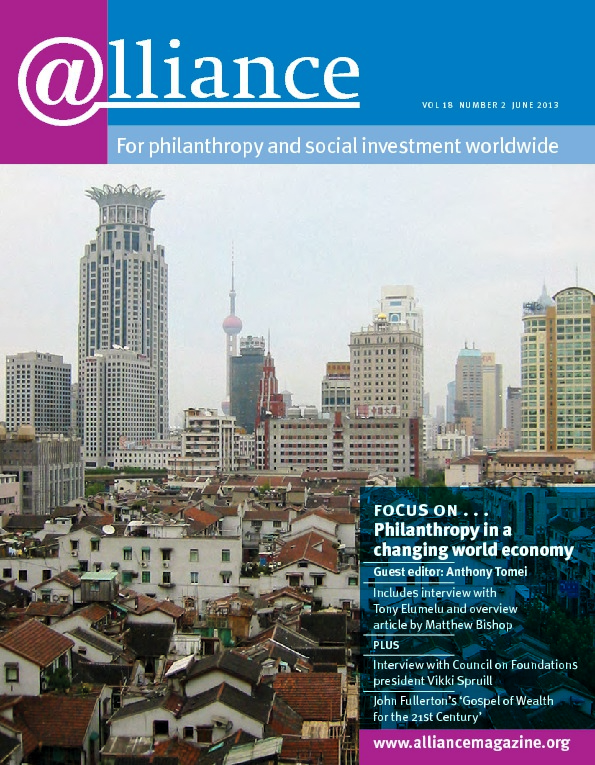When the financial crisis broke in 2008, Alliance asked a number of people around the world how its effects were playing out in their region and what they expected the consequences to be. We caught up with them again recently to see how their predictions had fared.
Akwasi Aidoo
2008
CSOs could become more creative in building local support, and those that survive the hard times ahead could become more resilient. And it could become easier to make the case to donors to dedicate more resources to helping African CSOs become more self-reliant.
2013
There are striking and inspiring examples of creative strategies for raking up African philanthropy in improbable conditions. Large-scale public fundraising is emerging on African soil; increasing numbers of high net worth individuals are stepping up to the philanthropic plate by setting up foundations; cross-national philanthropy by ordinary citizens is on the radar more than ever before. Consider this: on 1 August 2011, an 11-year-old Ghanaian schoolboy, Andrew Adansi-Bonnah, launched a $13 million fundraising drive, by walking from office to office in Accra, for Somali children.
Marcos Kisil, Brazil
2008
Some see the crisis as a way of separating real social investors from those who took to social investment as a corporate marketing strategy. The real social investors are fostering collaboration and partnership with other donors. There is also more attention to strategic planning and management of available resources, reflected in the way that grantmakerswork with grantees.
2013
Companies are more careful to make funding decisions that might result in an organization or initiative that is sustainable when the grant ends. The professionalization of corporate philanthropy has proceeded more quickly than that of family and community philanthropy. Corporate philanthropy has become more strategic.
Lucy Bernholz, USA
2008
Will fear about the future make people turn away from community, look for ‘others’ to blame, and be divisive and destructive to civil society? Will assumptions about large-scale transfers of wealth have to be re-examined in view of the scale of current uncertainty? Finally, how will online giving marketplaces, social enterprise, social investing and other innovations born in good times stand a downturn, short or prolonged?
2013
The last four years in America have been intensely divisive. As our reality has devolved into an ever more painful split between haves and have-nots, our political dialogue has become even more shallow. This is leading to new conversations about the role of communities, civic groups and informal networks, with a concurrent rise of peer-to-peer fundraising, community organizing and civic engagement. This suggests a growing sense that people can do things together, for themselves and their communities, including improving public systems.
Giving levels in the US have been essentially flat since 2008. Attention to impact investing continues to grow faster than the actual practice. I think the overall effect of the economic downturn has been to cramp the style of non-profits and philanthropic practices.
Atallah Kuttab, Arab region
2008
Some argue that corporate social responsibility will take on greater significance. With the Arab region still having the advantage of oil surpluses, many businesses will see a larger chunk of their profits being made in the region and may therefore be more willing to direct some of those profits to philanthropy and to causes popular with the general public like education, youth employment and Palestine.
2013
The Arab Spring uprisings have revolutionized the situation in the Middle East. Unfortunately, recent setbacks also mean an uncertain economic environment and so fewer funds for philanthropy. However, because citizen engagement is here to stay, companies will have to be more accountable to the communities in which they work and can no longer rely on rulers for protection. Partly because of this, corporate philanthropy in the Arab region has seen an exponential increase. However, apart from a few enlightened companies, the main thrust of this corporate philanthropy is still charity driven. On the other hand, the corporate sector’s emphasis on concrete results will drive recipient NGOs to focus more on results and ways to measure them, which will eventually improve the performance and accountability of the sector generally.
Janet Mawiyoo, Kenya
2008
We already have evidence of uncertain and reduced funding from our traditional sources. There is also the diminution of remittances from the North … But some new philanthropy avenues are likely to open. I think some very positive energy is being generated and getting us to think about opportunities we have ‘known’ about which have largely been dormant and about learning new strategies.
2013
It has not been all gloomy. Kenyans have proved very willing to give to other Kenyans in adversity – those affected by the post-election violence, for instance, or by the droughts in 2009 and 2011/12. While some non-profits had to close programmes as funding was withdrawn, new opportunities have meant that a good number of organizations have actually grown since 2008. Support for innovative work in addressing some of the continent’s critical issues, such as youth unemployment and growing entrepreneurial skills, has increased. Some local companies are investing significant resources in these areas and the number of corporate foundations in Kenya has grown in the last two years.



Comments (0)